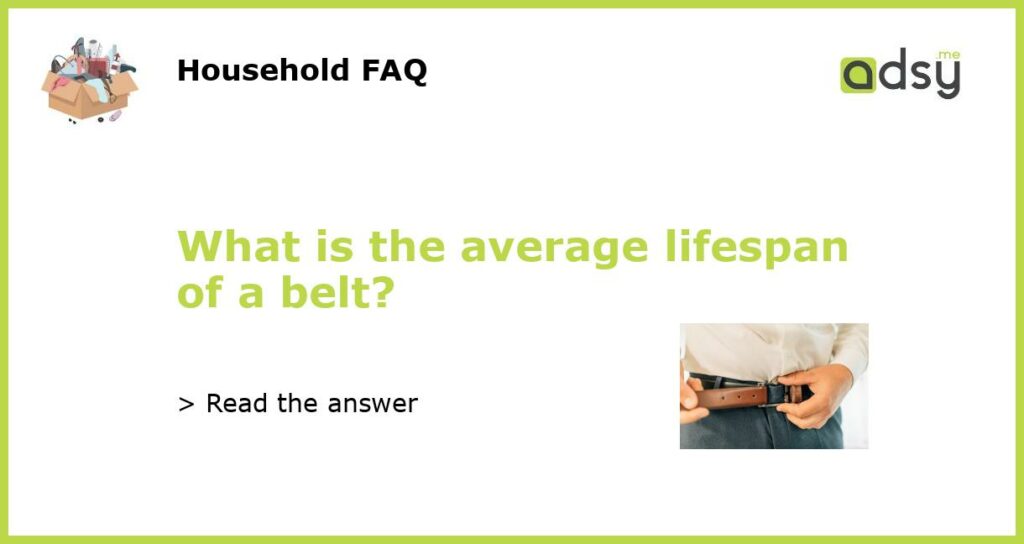Understanding Belt Lifespan: How Long Do Belts Usually Last?
Belts are a common accessory worn by both men and women, serving both functional and aesthetic purposes. They are often made of leather, fabric, or synthetic materials, and are used to hold up pants or skirts. But how long can you expect a belt to last before it needs to be replaced?
The Lifespan of Different Types of Belts
The lifespan of a belt can vary depending on several factors, including the quality of the materials used, the frequency of use, and how well it is cared for. Here’s a breakdown of the estimated lifespan for different types of belts:
Leather Belts
Leather belts are known for their durability and longevity. A high-quality leather belt can last for many years if it is properly cared for. With regular use and proper maintenance, a leather belt can easily last you 5-10 years or even longer. However, it is important to note that the lifespan of a leather belt can vary depending on the quality of the leather and the conditions it is exposed to. Exposure to moisture, extreme temperatures, or excessive wear can shorten the lifespan of a leather belt.
Fabric Belts
Fabric belts, such as those made from canvas or nylon, are generally less durable than leather belts. These belts are often used for more casual outfits and may not hold up as well under heavy use or strain. With regular use, a fabric belt can last you anywhere from 1-3 years. The lifespan of a fabric belt can be extended with proper care, such as avoiding excessive pulling or stretching, and washing it according to the manufacturer’s instructions.
Synthetic Belts
Synthetic belts are made from materials like faux leather, PVC, or rubber. These belts are often cheaper and less durable than genuine leather belts. The lifespan of a synthetic belt can vary widely depending on the quality of the materials used. Some synthetic belts may only last a few months, while others can last a couple of years with regular use. It is important to note that synthetic belts may not age as gracefully as leather belts. Over time, these belts may begin to crack or peel, making them less reliable and aesthetically pleasing.
Factors Affecting Belt Lifespan
While the type of belt material is a significant factor in determining its lifespan, there are other factors to consider as well:
• Frequency of Use: The more frequently you wear a belt, the faster it is likely to wear out. If you use a belt every day, it will naturally experience more wear and tear compared to one that is only worn occasionally.
• Care and Maintenance: Proper care and maintenance can extend the lifespan of a belt. This includes storing it properly when not in use, cleaning it according to the manufacturer’s instructions, and avoiding exposure to excessive moisture or extreme temperatures.
• Weight and Strain: Belts that carry heavy loads or are subjected to excessive pulling or stretching may wear out more quickly. If you frequently use a belt to support heavy items or perform physically demanding activities, it may degrade faster than a belt used for lighter purposes.
• Environmental Conditions: Exposure to moisture, extreme temperatures, or harsh chemicals can impact the lifespan of a belt. For example, a leather belt exposed to excessive moisture may develop mold or become weakened and lose its structural integrity.
When to Replace a Belt
Knowing when to replace a belt is essential for ensuring both functionality and style. Here are a few signs that indicate it may be time to replace your belt:
1. Visible Signs of Wear and Tear: Look for cracks, fraying, or peeling in the belt material. If the belt looks worn out or damaged, it is likely time for a replacement.
2. Slipping or Difficulty Holding Up Pants: If your belt no longer effectively holds up your pants or skirt, it may have stretched out over time and lost its elasticity or grip.
3. Buckle Damage: Check the buckle for any signs of damage or malfunction. If the buckle is broken or shows signs of wear, it may be time to replace the belt.
4. Uncomfortable Fit: As belts age, they may become stretched out or lose their shape, resulting in an uncomfortable fit. If your belt no longer fits properly or pinches your waist, it may be time for a replacement.
In conclusion, the lifespan of a belt can vary depending on the material, usage, care, and environmental conditions. Generally, leather belts tend to last the longest, followed by fabric belts, and then synthetic belts. However, with proper care and maintenance, all types of belts can be enjoyed for an extended period. Paying attention to signs of wear and tear and replacing a belt when necessary ensures both functionality and style.






